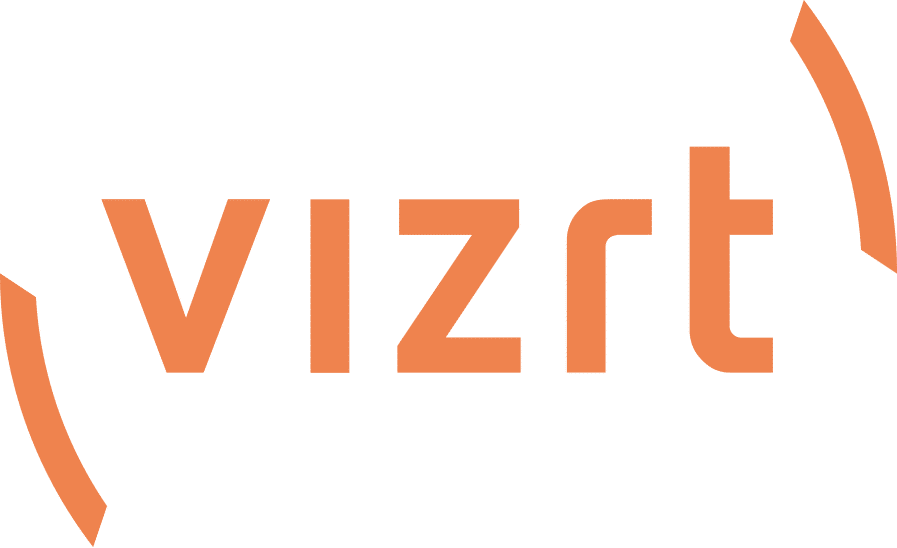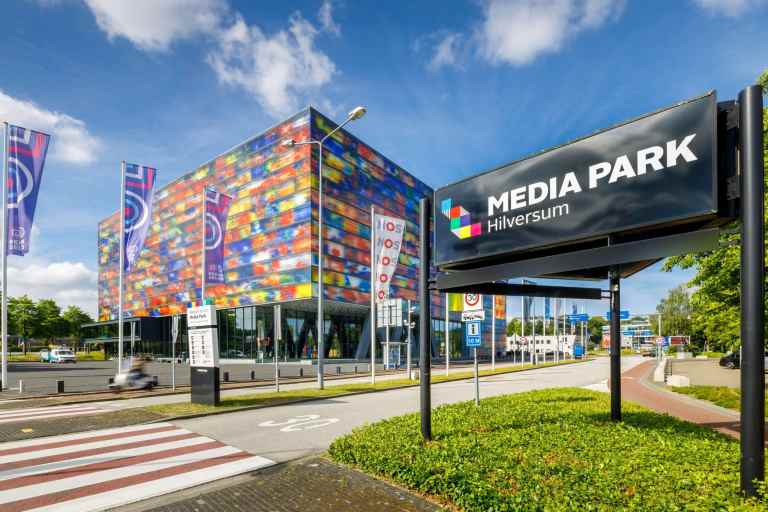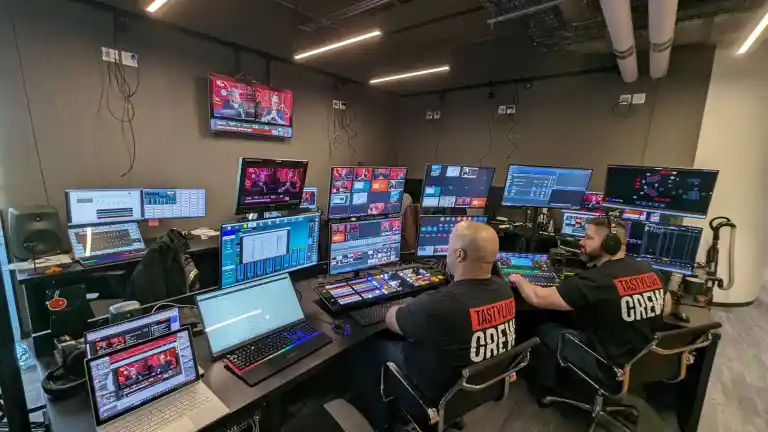Casey Green, Ben Betts, and Todd Stevens are idea men, devising concepts for compelling show formats, including live, interactive talk shows and game shows. As founders of WebCam Riot! Studios in Burbank, CA, they are also focused on solutions, conceiving technological setups and workflows that would make their unique concepts viable.

In early 2012, they partnered with paraMedia and Telepictures to bring a revised concept for the game show Let’s Ask America – during which four contestants competed while answering questions from their homes via Skype – to living rooms in EW Scripps Company markets across the country. Scripps had been looking to replace costly syndicated shows, such as Wheel of Fortune and Jeopardy, on its ABC affiliates with less-expensive homegrown programming. A pilot was made and tested well, and soon was picked up for 170 episodes.
Created within a rented traditional studio environment with a physical set, live audience, and high-end equipment, the show incorporated the interactive Skype concept but was live to tape, negating the need for some of the technical solutions the trio had been working on to support their novel show concepts.

Still determined to pursue their dream of true live, interactive content, Green, Betts, and Stevens opened WebCam Riot! Studios and pitched their Let’s Ask America partners on a localized, interactive, play-along version of the show. They received another green light, this time for four special episodes, which became the spin-off called Let’s Ask Cincinnati. It featured local players, locally-focused questions, and a local host, as well as the addition of viewer participation made possible by streaming a simultaneous interactive version of the show as the taped version was televised.
Like contestants on the show, they were presented with an all-important question: How could they create the project on a restricted budget, since production at the practical studio required an extensive crew and was very costly? Green and his group had an answer: They would replicate the practical studio environment using virtual sets, use a cost-effective workflow, and add an interactive element once each episode was locked.

While building the studio, the group focused on maximizing efficiency in all areas in an effort to keep facility costs as well as the subsequent production costs at a minimum. At the heart of the setup is a NewTek TriCaster 460, which offered an affordable, scalable, and reliable multi-camera virtual set system. A TriCaster 300 provides redundancy and downstream abilities. In addition, the studio contains Extron AV routers; a variety of Blackmagic Design hardware, including cameras, routers, and SSD recorders; AJA encoders and converters; Yamaha mixers; teleprompters; Telex RTS systems; and more. A large greenscreen and DMX iPad controlled lighting grid are also installed.
The three partners consider themselves early adopters of new, revolutionary, and democratizing technologies. When they started their own business several years ago, they followed that same path in getting their tech start-up and interactive content development studio up and running.
“Drawing on our extensive experience in the studio as professional video engineers, directors, and producers, and working on countless prime-time TV shows and blockbuster feature films, we realized we had the technical wherewithal to build our own professional multi-camera studio at a fraction of what it ‘should’ cost,” says Green.
Following a Dream
The trio’s drive for unique interactive show ideas and the required technology to support them dates back to 2009, when they set up a technology incubator to test some interactive concepts for live Web shows. “We spent a good amount of time figuring out how to incorporate multiple Skype feeds into a traditional multi-camera show,” says Green. “After conquering audio and video delays, and streaming and bandwidth issues, we created a few entertaining and compelling show formats – such as live, interactive talk shows and game shows.”
After getting interest from their sizzle reel, created at the incubator space, the group scored a deal that led to three seasons of Let’s Ask America. Contrary to the original concept, however, it was a live-to-tape show – the Skype callers were pulled in live at the studio, and there was a live, traditional audience, but the show was prerecorded, without any live, online interaction. It was also produced using the studio’s high-end equipment.
A ‘Green’ Solution
Soon the partners faced another difficult question: How do they mimic the traditional, practical studio set environment virtually, so that Let’s Ask Cincinnati would have the same look and feel of its national counterpart but at a fraction of the production costs? And, how would they incorporate the new interactive aspect? The answers were found inside their new studio, with the right combination of equipment and workflow.
“We put together a plan on how to best accomplish this, and brought one of our RED Epic Dragon 6K digital cinema cameras over to [the practical studio] to shoot the shiny-floored game show set while it was all lit up, from all the same angles that we used within the traditional show,” explains Green.

They then imported those images into the TriCaster 460 using the Virtual Set Editor feature, to re-create the space digitally. With Adobe’s Photoshop, they repainted the virtual floor with the revised Let’s Ask… moniker, replacing “America” with “Cincinnati.”
“We were able to completely re-create the set and match each angle to our studio cameras. After adjusting some monitors for the host [to match eyelines] and tweaking the lighting, it was a perfect match,” says Green. “Our colleagues were impressed with how much it looked like the original show, and here we were doing it for a fraction of the cost on a set that was ten times smaller.”
To accommodate the virtual imagery, the team installed a 30-foot greenscreen. “The host is sort of static with his movements, so we can make a much larger picture around him with a garbage matte,” explains Green.
In addition, the small crew color-corrected the imagery of the video signals containing the four Skype contestants (who appeared on the virtual projection screen), to make them appear less “perfect,” to more closely resemble the look of the projection screen of the practical Let’s Ask America set. Subtle virtual camera moves also helped sell the look.
Places On-Set
With the setup ready, the Let’s Ask Cincinnati host, Bob Goen, arrived at WebCam Riot! Studios, where four shows were recorded in one day. Four contestants for each show were connected via Skype, and the performances were recorded live to tape, just as they were for the national show.


An assortment of Apple Xserve servers handled the incoming Skype sources, which were fed to a quad-split window on the virtual projection screen. That split was then fed into the TriCaster 460 through Input 4. The host and greenscreen, meanwhile, were shot with Blackmagic Studio cameras.
The TriCaster then switched the virtual set, using one of three shots filmed with the Studio cameras: a wide shot showing the host and projector high and wide, a medium shot straight on from the audience perspective, and a close-up of the host. The group also used a clean close-up of the virtual screen, which was part of the virtual set (without needing an additional camera).
A TriCaster 300 generated the question-and-answer graphics during each round in the game. The output of the TriCaster 300 was recorded with the questions overlaid, while the TriCaster 460 output was recorded clean, meaning it did not contain the overlaid game graphics. This way, if anything had to be fixed or rebuilt in post, the team had raw camera elements from the 460 to work with.
After shooting and completing postproduction on the four episodes, the group added the interactive element using a custom software platform they helped develop. This allowed viewers to play along by clicking on their computer screen.

An assortment of Apple Xserve servers handled the incoming Skype sources, which were fed to a quad-split window on the virtual projection screen. That split was then fed into the TriCaster 460 through Input 4. The host and greenscreen, meanwhile, were shot with Blackmagic Studio cameras.
The TriCaster then switched the virtual set, using one of three shots filmed with the Studio cameras: a wide shot showing the host and projector high and wide, a medium shot straight on from the audience perspective, and a close-up of the host. The group also used a clean close-up of the virtual screen, which was part of the virtual set (without needing an additional camera).
A TriCaster 300 generated the question-and-answer graphics during each round in the game. The output of the TriCaster 300 was recorded with the questions overlaid, while the TriCaster 460 output was recorded clean, meaning it did not contain the overlaid game graphics. This way, if anything had to be fixed or rebuilt in post, the team had raw camera elements from the 460 to work with.
After shooting and completing postproduction on the four episodes, the group added the interactive element using a custom software platform they helped develop. This allowed viewers to play along by clicking on their computer screen.
FAST FACTS
WebCam Riot! Studios
- Located in Burbank, CA
- Converted warehouse space
- 2,000 square feet
- Stage: 900 square feet with 30-foot-wide greenscreen
- Also contains lobby, dressing room, server room, and control room
- Co-owners: Ben Betts, Casey Green, Todd Stevens
- Equipment
- Blackmagic Design Studio cameras
- Extron AV routers
- NewTek TriCaster 460 & 300
- AJA encoders and converters
- Yamaha O2R audio mixer
- Apple Macs
- RTS audio system
- Teleprompters
- Wireless Lavalier mics
- Backmagic Design HyperDeck SSD recorders
- Graphics/editing workstations running various software including Final Cut, Premiere, After Effects, and Photoshop

Let’s Ask Cincinnati
- Game show with contestants playing via Skype
- Viewers played simultaneously with Skype contestants via the Web
- A spin-off from the national Let’s Ask America game show
- Produced at WebCam Riot! Studios
- Ben Betts, Casey Green, and Todd Stevens were co-executive producers
- Green was also director
- Also produced by others at Scripps Network, Telepictures, and WCPO Cincinnati
- Show host: Bob Goen
- Used a virtual set
- Show was live to tape, with Web contestants playing live and linked in as the show aired
- Aired once a month starting in November 2014 on WCPO Channel 9 Cincinnati and on WCPO.com
- Local participants played for charity and included an Olympian, comedians, sports announcers and former players, Cincinnati BenGals cheerleaders, and even the mayor
- Memorable Moments: The tie-breaker section of the show, called the “Dash for Cash,” has players run around their home and perform silly tasks in front of their webcam Let’s Ask America
- Debuted September 2012
- Aired for 3 seasons
- Produced in a traditional studio with a live audience
- Created at Victory Studios in Burbank, CA
- Aired 5 days a week
- Half-hour episodes
- Hosted by Kevin Pereira (Seasons 1–2) and Bill Bellamy (Season 3)
- Broadcast in Scripps’ market on 16 ABC affiliates
- Reruns on Game Show Network More stories by Karen Moltenbrey





















